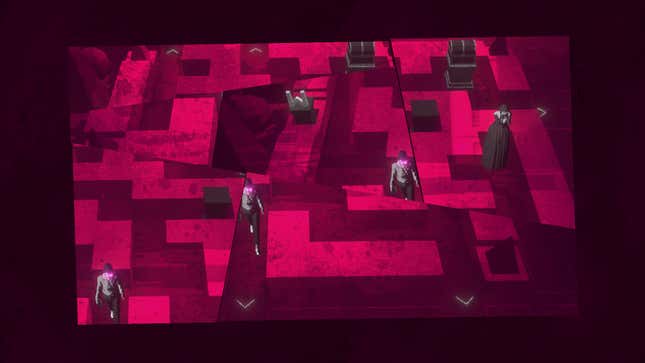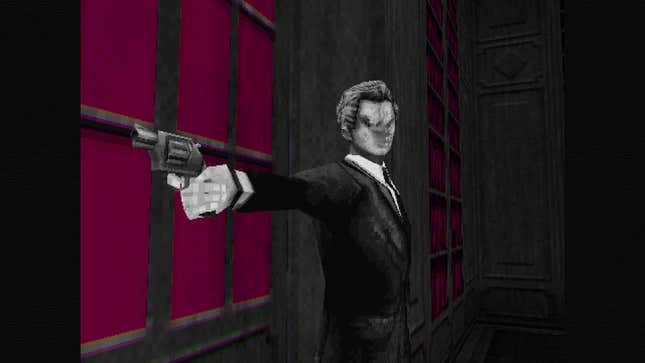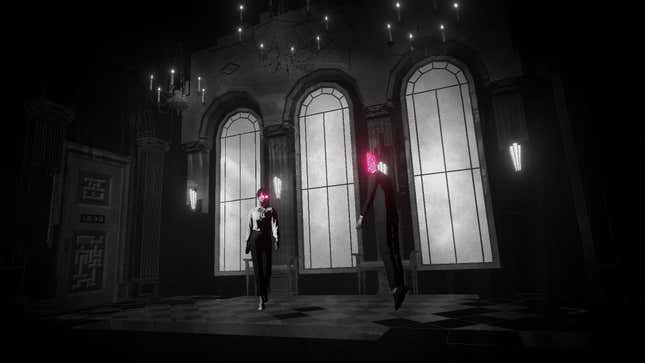You will never be able to stop thinking about Lorelei and the Laser Eyes. The latest game from developer Simogo, the team behind 2019’s Sayonara Wild Hearts and 2013’s buzzy, puzzly adventure game Device 6, will burn itself into your mind. That remains true even when you aren’t actively playing it, and continues long after you’ve solved its final puzzle.
Allow me to illustrate what I am saying the way the game would:
Int. NYC Apartment, Saturday Morning:
WOMAN makes coffee, while FIANCÉE eats breakfast
WOMAN (suddenly):
What if the key to opening [redacted] is using the [redacted]
FIANCÉE:
And then matching it to the [redacted]! Let’s go.
Five hours of gameplay followed. I can’t quite remember if I ever had coffee that morning.
Lorelei and the Laser Eyes is a puzzle game unlike anything I’ve ever experienced. Swedish developer Simogo, which has been innovating in the genre since at least 2013’s Year Walk, has crafted an immaculate interactive mystery dripping with style, rich with an enthralling story to unravel, and chock full of masterfully designed puzzles to obsess over. The game’s logic-heavy mechanics will immediately draw parallels to Lucas Pope’s seminal Return of the Obra Dinn. But just as that game’s innovations and influence made it a common point of reference for critics when reviewing games that followed, I can only assume we will start seeing critics drawing comparisons to Lorelei in much the same way. Simogo’s accomplishment is a step forward for not only the puzzle genre but video games as a whole.
Real eyes

Every good story, regardless of the medium, needs a good hook. It’s the thing that draws the audience in for the rest of the tale. Oftentimes the best hook is a simple question. In Lorelei and the Laser Eyes, that hook is a handful of questions: Who are you? Where are you? What are you doing here? Did I suddenly develop amnesia? Your goal is to find the truth to all these questions and more in a twisting narrative touching on the nature of art and its spectators. Grab a pen and paper, you’re going to need it.
Much of Lorelei and the Laser Eyes is hard to put into words. It’s a visual and mechanical feast for the senses. But here are the facts as I know them. The game takes place at a seemingly abandoned hotel and its surrounding grounds. The year is… well, that is a little harder to answer. Time is malleable within Lorelei and the Laser Eyes. While the hotel remains constant, the people and events within it seem to shift between decades and even centuries. But all of these realities live within the same physical space at once. The closest comparison I can make is to Tom Stoppard’s play Arcadia, in which two stories in different time periods play out in parallel on the same stage, nearly interacting with each other at all times. It’s discombobulating but purposefully puts you in a particular mindset. Things here defy easy explanations, so look beyond what your two eyes see.
Unraveling these questions requires progressing through the hotel’s many rooms, all of which are locked behind a series of exceedingly complex puzzles in a mazelike structure. Mazes are a running theme, and you’ll have to navigate a few of them in Lorelei and The Laser Eyes. While there are some padlocks and safe combinations you must crack, progressing is rarely that simple. To describe the puzzles you encounter in detail would ruin much of the fun, so I won’t spoil them here in detail, but they feel more akin to the ones in cult mystery puzzle book Cain’s Jawbone than those I’ve seen in any other video game. Most often, Lorelei will present you with a puzzle and you either know what you need to do or you don’t. The puzzles are so compelling that you’ll often find yourself thinking about them even when you’re not playing, and though realizing the solution might take you hours, it feels so good when your subconscious finally hits on a likely solution as you’re just going about your day.

To ensure that you always have information on hand, the game’s protagonist has a photographic memory. Every image you look at or document you read is available to reference from the game’s menu. However, even with this information, every puzzle requires some real problem-solving on your part. No single puzzle is necessarily “easier” than another, they are just different, and your experience of them will vary based on your own skillset. Are you good at recognizing patterns? Do you have a solid inner compass? Have you memorized your Roman numerals? Some people will solve certain puzzles long before others, which leads to an interesting diversion in paths from player to player that only confirms how intricately crafted every part of the game is. The feeling of satisfaction I felt at solving a puzzle never went away, and it’s only encouraged by the game’s split-second pause between entering a solution and learning if you were correct or not.
Still, it’s not entirely without its pain points. While backtracking through the hotel between puzzles isn’t tedious, the constant backtracking between menus and puzzles is. You constantly need to reference in-game documents in your photographic memory, but there is no back button for menu navigation. It’s not game-ruining by any means, but after navigating through menus for sixteen hours, I really wished I could just press a button to exit my photographic memory instead of navigating to the exit button every time. That problem also extends to puzzles, which require you to enter a solution to exit the puzzle screen. That can grow annoying when you know you don’t have the answer yet but you just want to give the puzzle a look in order to do some brainstorming.
Realize

The aesthetic and mechanical layers of Lorelei and the Laser Eyes are just as impressive as the puzzles. The game is entirely rendered in greyscale, except for the occasional pop of red. But if the color palette seems reserved, it’s only because that isn’t the limit of the game’s art direction. It took me walking through a handful of different environments to realize that there’s a layered effect at play. Every 3D environment has a photo projection laid behind it. For example, the facade of the central hotel has a photo of a similar-looking building’s facade laid behind it. It gives an uncanny feel to every room you step into, blurring the lines between fiction and reality.
But Simogo didn’t stop at just two layers. The deeper I went into Lorelei and the Laser Eyes, the more layers there were. Again, describing exactly what those layers are risks spoiling the best moments of the game, but they are there and they are expertly woven in. Lorelei and the Laser Eyes continues to shift its form in new and unexpected ways. It takes the form of game design and uses it as a puzzle in itself.
Of course, the grandest puzzle of Lorelei and the Laser Eyes is the story, a fact which highlights another masterful trick the game pulls off. As you solve puzzles, you’re also absorbing morsels of information that will finally lead you to answer those questions that hooked you in the first place. The puzzle solutions are the narrative at play. They feed the story, and the story feeds the puzzles in a perfect symbiotic relationship. And it’s a compelling narrative that will likely be a treat for fans of metanarrative games about art like last year’s Alan Wake 2 or 2022’s Immortality.
The game’s clashing and changing mechanical and visual styles are a reflection of the central conflict the characters within are struggling with. It’s a question of art. Each character within the game has their own concept of what the purpose of art is and who, if anybody, it is for. “A piece of art exists in itself and for itself,” one in-game document reads. “All art can and should not be for mankind.” But that’s just one of several conflicting ideas on display. Another character discusses art as a vital resource for life, something that must be consumed. Wrapped up in this are questions about artistic legacies, the preservation of digital art, and more. It’s enough to make your head spin, and it likely will for a good chunk of your playtime. But it’s always fascinating when you find a kernel of the story that digs into these themes more.
Once you reach the last moments, the game asks you one final question: have you been paying attention? It’s a stunning test not only of your own logic-solving skills but also of your deductive reasoning in regards to events within the game. Creating an ending for a mystery game is a puzzle in itself because so much of a player’s time is spent theorizing how the story will end, only for their theory to potentially be better than the final reveal. Lorelei and the Laser Eyes is so confident that it does not feel the need to show the cards up its sleeve in service of wrapping things up neatly. Instead, Lorelei and the Laser Eyes gives you enough answers for that much-needed catharsis of a mystery solved, but still leaves some questions as to the exact details of events. By keeping some cards up its sleeve, as opposed to wrapping everything up neatly, the game perfectly pulls off its tricks.
Real lies

I’ve made a lot of comparisons between Lorelei and the Laser Eyes and other pieces of media in this piece. That’s because the game is so hard to get a handle on. It’s so incredibly multifaceted and pulls on so many artistic mediums. It is one part memory play, one part puzzle game, one part mystery novel. It is the way all of these puzzle pieces fit together that shows Lorelei’s true art, and the act of being the one to connect them that makes it all so satisfying.
Lorelei and the Laser Eyes is an amalgamation of influences living alongside one another in the same way the hotel in which it is set seems to hold so many times at once. It’s a reflection of the game’s biggest questions. What is the point of creating and consuming art? Is it a curse, or a gift? That’s the big mystery at the heart of Lorelia and the Laser Eyes. The answer is up to interpretation, but as it exists within such a carefully crafted maze of twisting puzzles and story beats, I can only assume this kind of gift for creating art is just that, a gift. And we, the players, are its lucky recipients. At least that’s my perception of it, and that’s about as close to the truth as I’ll get.
.
